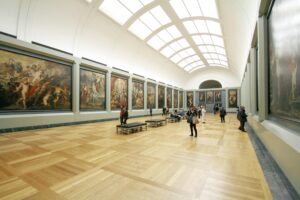Discover the most Epic museums in Florence
Florence, Italy, often referred to as the “Cradle of the Renaissance,” is a city that bursts with history, art, and culture at every corner. For those who love to immerse themselves in the richness of the past, the museums in Florence are a treasure trove of unparalleled masterpieces and historical artifacts. Whether you’re a seasoned art enthusiast or a curious traveler looking to soak in some culture, the museums of Florence offer something for everyone. Here’s a guide to the best museums in Florence that you won’t want to miss.
1. The Uffizi Gallery: A Journey Through Renaissance Art
Why Visit?
The Uffizi Gallery is one of the most famous and visited art museums in the world. Housed in a grand 16th-century building originally designed by Giorgio Vasari, the Uffizi boasts an unparalleled collection of Renaissance art. Here, you can find works by some of the greatest artists of all time, including Leonardo da Vinci, Michelangelo, Botticelli, and Raphael.
Highlights
- Botticelli’s “The Birth of Venus” and “Primavera”: These iconic paintings are a must-see for any art lover.
- Leonardo da Vinci’s “Annunciation”: Witness the early work of this genius artist.
- Michelangelo’s “Doni Tondo”: A stunning piece that showcases Michelangelo’s mastery of color and form.
- The Hall of Statues and Paintings: Stroll through this breathtaking corridor filled with ancient sculptures and Renaissance masterpieces.
Tips for Visiting
- Book Tickets in Advance: The Uffizi can get very crowded, so it’s best to book your tickets online to skip the long lines.
- Take a Guided Tour: To truly appreciate the depth and significance of the artworks, consider taking a guided tour.
2. The Accademia Gallery: Home of Michelangelo’s David
Why Visit?
The Galleria dell’Accademia is another must-visit museum in Florence, primarily known for housing Michelangelo’s David, one of the most famous sculptures in the world. Beyond David, the museum also boasts a remarkable collection of Renaissance art and sculptures.
Highlights
- Michelangelo’s David: This 17-foot-tall marble masterpiece is a symbol of Renaissance art and humanist ideals.
- The Hall of Prisoners: Featuring Michelangelo’s unfinished sculptures known as the “Slaves” or “Prisoners,” which provide insight into his artistic process.
- Renaissance Paintings: The gallery also has a notable collection of paintings from the 13th to the 16th centuries.
Tips for Visiting
- Arrive Early: To avoid the crowds, try to visit the museum early in the morning.
- Focus on Details: Take your time to appreciate the details of Michelangelo’s sculptures, especially the realism and anatomical precision of David.
3. Palazzo Pitti: A Royal Experience
Why Visit?
The Palazzo Pitti is a vast Renaissance palace that was once the residence of the powerful Medici family. Today, it houses several museums and galleries that offer a diverse range of art collections, from Renaissance paintings to modern art.
Highlights
- Palatine Gallery: Located on the first floor, it features over 500 paintings, including works by Raphael, Titian, and Rubens.
- Royal Apartments: Get a glimpse into the opulent lifestyle of the Medici with a tour of the beautifully decorated rooms.
- Boboli Gardens: After exploring the museum, take a stroll through the expansive and beautifully landscaped gardens.
Tips for Visiting
- Explore the Gardens: Don’t miss the Boboli Gardens, as they provide a serene escape and fantastic views of Florence.
- Multiple Museums: The Palazzo Pitti complex includes several museums, such as the Gallery of Modern Art and the Silver Museum, so allocate plenty of time for your visit.
4. Bargello National Museum: A Sculptural Delight
Why Visit?
The Bargello Museum, housed in a former medieval prison, is a paradise for sculpture enthusiasts. It features an extensive collection of Renaissance sculptures and decorative arts, including masterpieces by Donatello, Michelangelo, and Verrocchio.
Highlights
- Donatello’s “David”: A groundbreaking bronze statue that represents a significant shift in Renaissance art.
- Michelangelo’s “Bacchus”: A fascinating early work by the artist, depicting the Roman god of wine.
- Ghiberti’s “Saint Matthew”: One of the famous bronze statues from the Florentine Baptistery.
Tips for Visiting
- Historical Ambiance: The museum itself is a historical treasure, with its medieval architecture adding to the experience.
- Detailed Observation: Pay close attention to the intricate details of the sculptures, especially the expressions and drapery.
5. Museo dell’Opera del Duomo: A Glimpse of Florence’s Religious Heritage
Why Visit?
The Museo dell’Opera del Duomo is dedicated to the art and history of Florence’s iconic cathedral, the Duomo. The museum houses many original works of art that were once part of the cathedral, its bell tower, and the baptistery.
Highlights
- Michelangelo’s “Pietà Bandini”: An emotionally powerful sculpture created late in Michelangelo’s life.
- Ghiberti’s “Gates of Paradise”: The original gilded bronze panels from the baptistery’s east doors.
- Brunelleschi’s Dome Models: Learn about the fascinating construction process of the Duomo’s magnificent dome.
Tips for Visiting
- Combined Tickets: Consider purchasing a combined ticket that includes entry to the museum, the cathedral, the dome, and the baptistery for a comprehensive experience.
- Historical Context: Take time to read the descriptions and watch any available videos to fully understand the historical and artistic significance of the exhibits.
Florence is a city where history and art come alive, and its museums are the perfect gateways to explore its rich cultural heritage. Whether you’re marveling at the masterpieces in the Uffizi Gallery, standing in awe of Michelangelo’s David, or wandering through the opulent halls of Palazzo Pitti, each museum offers a unique and unforgettable experience.
By planning your visits and taking time to appreciate the details, you’ll discover why Florence remains one of the most cherished destinations for art lovers and history buffs alike.
